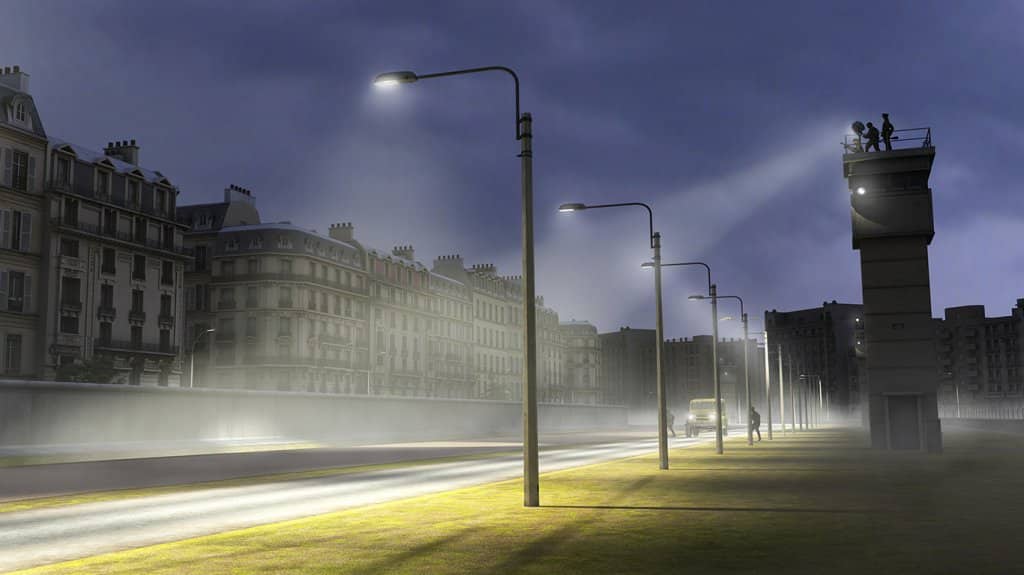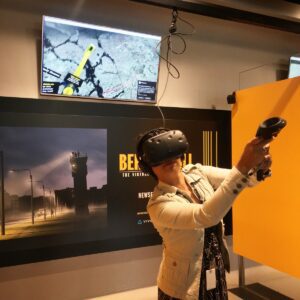A new Berlin Wall VR experience at the Newseum has opened this summer. The Berlin wall came down on a cold November day in 1989. While only remnants of the wall exist in Berlin today its impact is no less significant on the lives of people across the world.
The physical wall is gone but that day is etched in my consciousness. And it changed the course of my life profoundly. I often go back to the days, weeks, months following the fall. The images of people walking down the streets with grim faces in raincoats, the wind sweeping the fall leaves have been with me for years. I push the play button in my mind and I can re-live it all, but for years I wanted to share this moment with others and VR and MR may give me an opportunity to do it. The Newseum along with HTC Vive and the University of Maryland has created a short Berlin Wall VR experience, an illustration of what may be possible in the future.
I have written essays, given talks, shared memories and answered questions about my experience growing up behind the Iron Curtain. Talking about the Berlin Wall always evokes an emotional response to those around me, it is a powerful experience to translate. As a witness and a storyteller, I have developed the language to tell my own story. But it always left me asking whether my 10-year-old niece, my Brazilian friend, my American colleagues actually get it.

The Berlin Wall VR Experience
With the birth of VR, I have experienced things I have never thought possible. I’ve landed on the Moon, visited Mars, and walked through ancient sites on earth. I’ve stepped into the shoes of a homeless person trying to survive every day and shed tears after visiting refugees camps and hearing children’s stories. The new Berin Wall VR experience in the Newseum has made me wonder if VR can better tell the story of the fall of the Berlin Wall to my niece, my friends, and my future students?
The Newseum VR experience gives visitors a glimpse of the Berlin Wall site. With the HTC Vive headset and headphones, you can walk through the streets of East Berlin and see the communist propaganda posters. With room-scale VR, visitors can walk within a 10×10 foot space and experience the anxiety of dodging the guard tower searchlights looking to spot wall jumpers. On the West Berlin side of the wall, visitors can use their controllers to help break down the iconic barrier to freedom.
It’s a way to reach a young generation and give those like me another chance to reflect. What is different is that with VR, it becomes your story. It’s an opportunity to get closer to events and a sense of place. It will likely have a different impact on different people and no I do not see it as immediately transformative but I do believe that it has the power to make us all reflect on the significance of these events.
VR Stories and Storytelling
Storytelling in VR is a fascinating topic for viewers and creators experimenting with this new medium. Projects like the Berlin Wall VR experience can become the beginning of conversations that can trigger transformation over time. VR stories will become more multifaceted and not only illustrate journeys but also allow a space for different personal narratives to emerge. We will no longer be mere visitors but involved participants.
VR as a medium has the power to transport us to a place and time. But to fully immerse ourselves we need to be able to go back, connect to the world and create our own memory and a story to tell. As we develop the medium our ability to return, meet others or encounter and interact with AI-powered characters will make these experiences to feel less of a tour or a ride and more of a personal memory.
The true power of VR stories will be to feel very much like real life. As genres develop in this new medium, we will see different ways to share stories in VR and MR. I believe that keeping our collective memory and being able to experience stories from multiple perspectives will continue to drive us forward in this immersive medium.
New Media World Narratives
Now only 28 years later, we have moved to a new century receiving and contributing to multiple streams of both global and local news transmitted over fiber networks powered by journalists and individuals from around the world, chat boats and AI. We are racing to understand the world where events take nanoseconds to appear as alerts on smartphones screens and “fake news” proliferates. As new generations grow and older ones try to make sense of the word, I have often thought about the power of experiences that bring transformative change. Now VR and MR are opening a new frontier of human experiences that are not bound by time and space. Human experiences that instead of telling us stories like previous mediums can let us live in stories.
Events like the fall of the Berlin wall have given me the opportunity to think, reflect, hope and at the same time driven my personal and intellectual pursuits higher than any academic lesson ever did. In the age of rethinking higher education, I often wonder if I would have had the perseverance, and curiosity without having lived through these events, without seeing my family and friends struggle with this new reality.
My life following the fall of the Wall meant living through profound change and I’m often critical when people use the phrase “transformative” to describe events with far less significance and impact. Words matter to me – they’re born from my very experience of walking the streets and seeing peoples faces and living through change.
I wonder if the Berlin Wall VR experience will give us new ways for students to see and become aware of ideas and events, to collaborate and reflect on their place in the world. For that to happen, VR has to mature far beyond where it is today. The state of VR and MR today is where the Lumiere Brothers were in 1895 – hardly more than flickering images on a wall.
But it is a medium with tremendous potential for the future of storytelling. A future where others will experience what I went through first-hand. And it will be just as real for them as it was for me.
28 years ago a wall fell, changing my life and much of the world. Today we breaking through the boundaries to discover a new medium and tell new stories.
Maya Georgieva is an EdTech and XR strategist, futurist and speaker with more than 15 years of experience in higher education and global education policy. Her most recent work focuses on innovation, VR/AR and Immersive storytelling, design and digital strategy. Maya actively writes and speaks on the topics of innovation, immersive storytelling and the future of education and consults organizations and startups in this space.

